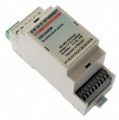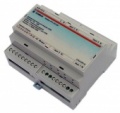All devices presented in this catalog use data exchange with each other. Almost all communication devices use a cable.
Data Interfaces
RS-485 interface
Most devices in this directory operate using the RS485 bus.
1.1. Interface, physical layer standard - EIA / TIA-485-A (RS-485), half duplex. 2 wires A and B are used.
1.2. Some devices support full duplex operation and are referred to as RS422. 4 wires A, B, Y, Z are used.
1.3. Some devices do not have galvanic isolation between the RS485 / RS422 bus and power. But some devices have galvanic isolation between the RS485 / RS422 bus and power supply up to 2000V.
1.4. The number of data bits is 8. There are no other options and cannot be changed.
1.5. The default number of stop bits is 2. It is possible to set 1 and 2 stop bits. But they only affect the transmitter. Those. pause between bytes increases. On reception, the interface focuses only on the leading edge of the start bit in the packet. The number of stop bits 1, 2 or 10 for the receiver does not matter, it will receive the same and the quality will not change.
1.6. The default parity bit is missing. You can change to: even and odd, but this will not affect the quality of the transfer, although it will add another bit. Better left by default.
1.7. The default data rate is 9600 bps. The speed can be changed to several fixed values. 9600, 19200, 38400, 57600, 115200 bps.
Ethernet interface
Some devices in this directory operate using the IEEE 802.3 Ethernet standard.
2.1. Used cable 2 twisted pairs category UTP5.
2.2. Data transfer rate 10/100 Mbit / s. Higher device speeds do not support and are used only in the controller.
2.3. The lower layer protocol is TCP / IP. UDP is not used.
2.4. Top-level protocols that use modules: Modbus TCP, Http, MQTT, etc.
Modbus Communication Protocol
3.1. 2 types of Modbus RTU and Modbus TCP protocol are used.
3.2. Support for functions and commands is provided in full accordance with the syntax of the request and response defined in the document "MODBUS Application Protocol Specification v1.1b". A full description of the protocol is on the official website: ModBus.org.
3.3. The operating mode of the module is “Slave” (slave).
3.4. Information transfer mode - “RTU” or “TCP”.
3.5. Used functions (commands) of information exchange:
| function code | Memory area |
Name |
Address range |
|---|---|---|---|
| 01 | 20001 - 29999 | Read Coils | 0 - 65535 |
| 02 | 10001 - 19999 | Read Discrete Inputs (DI) | 0 - 65535 |
| 03 | 40001 - 49999 | Read Holding Registers (HR) | 0 - 65535 |
| 04 | 30001 - 39999 | Read Input registers (IR) | 0 - 65535 |
| 05 | 20001 - 29999 | Write Single Coil | 0 - 65535 |
| 06 | 40001 - 49999 | Write Single Register (HR) | 0 - 65535 |
| 15 | 20001 - 29999 | Write Multiple Coil | 0 - 65535 |
| 16 | 40001 - 49999 | Write Multiple registers (HR) | 0 - 65535 |
• Discrete Inputs - Discrete inputs of the device are read-only. Abbreviated DI. The range of register addresses is from 10001 to 19999. They have the function “02” - reading a group of registers.
• Coils - discrete outputs of the device, or internal values. Available for reading and writing. The range of register addresses is from 20001 to 29999. It has functions: “01” - reads a group of registers, “05” - writes a single register, “15” - writes a group of registers.
• Input Registers - 16-bit device inputs. Short for IR. Read only. The range of register addresses is from 30001 to 39999. They have the function: "04" - read a group of registers.
• Holding Registers - 16-bit device outputs, or internal values. In short HR. Available for reading and writing. The range of register addresses is from 40001 to 49999. It has functions: "03", "06", "16".
3.6. Module address - according to the MODBUS protocol, it is indicated by Slave ID. By default, all modules have an address of “1” or “34”. For the MODBUS protocol, an address can only be changed by writing another address to register 0. If the address is not known, then the recording must be done by a broadcast command at the address of module 0 in register 0, but there should only be one module on the bus. The device address will only change when the device is restarted.




